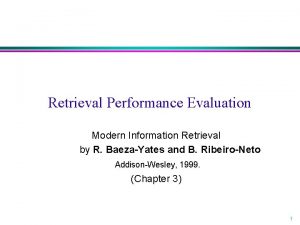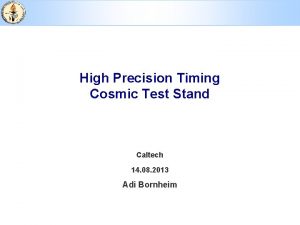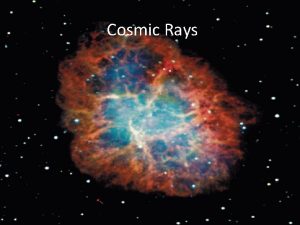High Precision Timing Cosmic Test Stand Caltech 14




- Slides: 4

High Precision Timing Cosmic Test Stand Caltech 14. 08. 2013 Adi Bornheim

Goals for the timing studies Ø Tag cosmic muons with a precision of a few 10 ps. ¡ Once achieved, can start benchmarking other devices (eg. MCP) Ø Study the timing properties of scintillating crystals and explore the feasibility of a scintillator based precision timing device for LHC. 1 8 5 4 7 7 6 4 2 3 2/21/2021 Caltech Test Stand Meeting 2

Precision Timing with Crystals Ø For our target application in LHC, with scintillating crystals we have a large number of scintillation photons : Ø The challenges we face might be different then the ones other precision timing devices have : Ø Quasi infinite number of photons, arriving over a period of ~few ns. Need to study this dynamic precisely. 2/21/2021 Caltech Test Stand Meeting 3

Optimizing the timing performance Precise timing from a scintillation detector : 1) Time pattern of the energy deposit (now muons, later photons, other particles). Particle path length and shower development in the crystal. For cosmic test stand we can adjust the trigger counter geometry such that the muon traverses the crystal in a geometrically small region, making the pass length uniform and equidistant to both ends of the crystal. Cedric studies in full CMS. 2) Time pattern of the scintillation process. We can study by comparing eg. LYSO and Ba. F 2 which are almost maximally different in this respect. But this pattern is invariant from event to event, modulo photo statistics. The latter we have to study. 3) Light propagation through the crystal. For the very simple geometry of a muon perpendicular through the crystal this should be simple. Artur has studied this in detail for more complex situation like actual photon showers from a front high energy photon, including the Cerenkov component. This will become more challenging later in eg. a test beam with high energy photons. 4) The readout : photo detector, amplifier, DAQ, etc. For current ECAL, the systematic limit in the test beam was around a few 10 ps with an APD, pulse shaping, 25 ns sampling and subsequent timing reconstruction using 10 samples. We started to explore what are the limits for PMTs with scope readout, alternative technologies - Si. PMs, dedicated DAQ to come. Very fast photo detection has been achieved by others, need to learn from others how to do this. 2/21/2021 Caltech Test Stand Meeting 4







